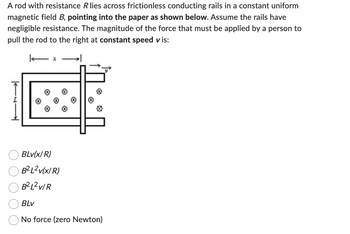Question

Transcribed Image Text:A rod with resistance R lies across frictionless conducting rails in a constant uniform
magnetic field B, pointing into the paper as shown below. Assume the rails have
negligible resistance. The magnitude of the force that must be applied by a person to
pull the rod to the right at constant speed vis:
- x
>
BLv(x/R)
B²L²v(x/R)
B²L² v/R
BLv
No force (zero Newton)
Expert Solution
This question has been solved!
Explore an expertly crafted, step-by-step solution for a thorough understanding of key concepts.
This is a popular solution
Trending nowThis is a popular solution!
Step by stepSolved in 2 steps

Knowledge Booster
Similar questions
- Figure (a) shows a wire that forms a rectangle (W = 19.0 cm, H = 29.0 cm) and has a resistance of 4.50 mQ. Its interior is split into three equal areas, with magnetic fields B and B B 2' The fields are uniform within each region and directly out of or into the page 1, 3. as indicated. Figure (b) gives the change in the z components B, of the three fields with time t; the vertical axis scale is set by Bg = 4.50 µT and Bp = -2.50B5. What are the (a) the magnitude and (b) direction of the current induced in the wire? B5 H B2 t (s) (a) (b) (a) Number i 2.75E-5 Units A (h) COunterclockwise B. (uT)arrow_forwardLet's take the Earth's magnetic field BE = 1.70 x 10-4 T pointing north. A metal cable attached to a space station stretches by 1.4 km. What would be the potential difference ( ΔΔ V) that develops between the ends of the cable if it’s traveling eastbound around Earth with a speed 4.4 km/s?arrow_forwardTwo lined conductors are connected by a resistor R=30Ω, and separated by L=5. A moving conductor of mass m slides on the conductors at a constant speed v, which produces a current I=4 A. The conductors are placed in a B=6T magnetic field out of the page. In what direction does the current flow through the moving conductor when the bar is sliding in the direction as shown in the figure? From the previous question, calculate the speed at which the bar is moving. From the previous question, calculate the magnitude and direction of magnetic force on the bar.arrow_forward
- The current in a long, straight conductor has the following form:I(t) = I0cos ωtWhat is the magnitude of the magnetic field a distance r away from theconductor?arrow_forwardDiamagnets have the property that they "dampen" the effects of an external magnetic field by creating an opposing magnetic field. The diamagnet thus has an induced dipole moment that is anti- aligned, such that the induced north pole is closer to the north pole creating the external field. An application of this is that diamagnets can be levitated 2. Now, the mathematics of generally describing a force by a non-uniform field on a dipole is a little beyond the scope of this course, but we can still work through an approximation based on energy. Essentially, whenever the theoretical loss of gravitational potential energy from "falling" no longer can "pay the cost" of increasing the magnetic potential energy, the object no longer wants to fall. Suppose a diamagnetic object floats above the levitator where the magnitude of the magnetic field is 12 T, which is inducing" a magnetic dipole moment of 4.6 LA - m² in the object. The magnetic field 1.9 mm below the object is stronger with a…arrow_forwardA cube of edge length e = 6.0 cm is positioned as shown in the figure below. There is a uniform magnetic field throughout the region with components B, = +7.0 T, B, = +2.0 T, and B, = +7.0 T. (a) Calculate the flux through the shaded face of the cube. T•m2 (b) What is the net flux emerging from the volume enclosed by the cube (i.e., the net flux through all six faces)? T•m²arrow_forward
- Two conducting plates are in parallel and carry net charge of opposite signs with the same magnitude. A particle with negative charge -q is sent into the region between the plates with speed v as shown. What must be the direction of the uniformn magnetic field in the space between the plates such that -q passes in between the plates with no deflections?arrow_forwardA current I is passed through a wire. A second wire of length L is moving perpendicular to the magnetic field generated by the first wire (see sketch below) with velocity v at a distance d. Write down the expression for the potential difference V between the ends of the moving wire. Consider the magnetic field B to be constant over the range of motion of the second wire (i.e. d » 1). Use μ for the vacuum permittivity. Please use appropriate algebraic symbols for multiplication (* for a × b), division (/ for a/b), exponents (a^b for a³), square root (sqrt(a*b/c) for √a× b/c) etc. For Greek letters use their names e.g. "theta", "alpha", "pi", "mu" (without the quotes) and for trigonometric functions use "cos", "tan", "sin" (without the quotes). Thus for Acose use A*cos theta. Please use the "Display response" button to check you entered the answer you expect. Wire 1 Wire 2 d Varrow_forwardPlease asaparrow_forward
arrow_back_ios
arrow_forward_ios